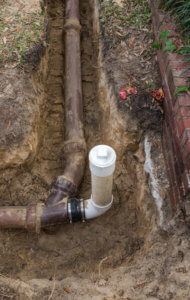How To Find The Main Sewer Line In Your House
Need to find the main sewer line in your house? If so, you’ve landed on the right page! In this short article we’re going to briefly explain how your home’s drainage system works, and then tell you how to find your home’s main sewer line.

How your home’s drainage system works
Wastewater pipes – both from drains and from your toilet – move dirty water out of your home. They carry wastewater from different locations – kitchen sink, toilet, shower, laundry room, etc. – but at some point they all drain into your home’s main line. From there, a lateral line carries the wastewater to either a septic tank on your property, or to the city main line in the street.
So, the flow of wastewater out of your home can be summed up as follows…
Individual drains and toilets > house main > lateral line > septic tank, drain field or city main.
Your home’s main line will have at least two sewer cleanouts, each covered with a sewer cleanout cap. A cleanout is used to easily gain access to a pipe in case of a blockage.

How to find the main sewer line in your house
If you want to find the main sewer line in your house and have either a basement or a crawlspace…
Find a drain line you’re sure about and then follow it until you see it connect with a larger pipe that then exits the basement or crawlspace. That larger pipe is the building’s main sewer line.
If you don’t have a basement or a crawl space, or maybe you can’t find the larger pipe, don’t give up. There are a few other things you can try…
Learn more about: How to Replace Sewer Line
Ask the home’s previous owner
If you know who owned the house before you did, and you know how to reach that person, this might be the easiest way to find the main sewer line in your house. If you don’t know who that person is, you can contact the County Recorder’s office. They should have all the deeds that were ever filed for your home.
Call the city and ask
Call the municipality’s local zoning or building office and ask. They will probably know.
Locate your septic tank
If you have a septic tank, pinpoint its exact location. The building’s main line will go from the septic tank back to the house.

Call a sewer repair professional
Calling a professional is almost always the quickest way to solve a problem. A sewer repair contractor will be able to quickly tell you the location of your home’s main sewer line.
Read also: How Does A Sewer System Work
Check to see if your city has online maps
Many US cities have online maps that show your home’s connection to the public sewer system. For example, Portland Maps allows homeowners in Portland, Oregon to enter their address and instantly see their connection to the public sewer line. You can see Los Angeles County’s sewer lines here. Check to see if your city offers the same service. Some cities offer detailed information. For example, you might be able to click on a sewer line and see how deep it is. Pretty cool, huh?
Call 811
If you’re in the US, you can simply call 811 and ask for someone to come out and mark your buried lines with either paint or small flags. This is a free service. Visit the website for more information.
Use a pipe locator
You can also use something call a pipe locator. However, they’re expensive – around $1000. If you can rent one, this is another way to find the main sewer line in your house.
So, how do you use a pipe locator? Well…
There are two parts to a pipe locator, the detector/transmitter that goes into the pipe, and a wand that locates the line. To use a pipe locator…
Turn on both the detector/transmitter and the wand, and make sure they’re set to the same frequency.
Feed the detector/transmitter about 15 feet into either a sewer cleanout or a drain. If it doesn’t go in all the way, you might have a clog. Don’t put the transmitter in through a toilet because it won’t work properly.
Now, point the wand at the ground, wave it around, and look for a strong signal. Start walking in the direction of the sewer line (or where you think it is) while moving the wand around. The wand will beep as you do this and start to beep louder as you approach the end of the detector/transmitter.
But where is the end of the transmitter exactly? Here’s how to find it…
Reduce the sensitivity of the wand and listen for the loudest signal. When you find it, reduce the sensitivity again, and listen for the loudest signal again. Keep doing this – reducing the sensitivity and listening – until the loud pitch stops.
When you find an area that creates a signal, but waving the wand around produces no sound, that’s the end of the detector/transmitter. So, mark this spot in some way.
Now, extend the detector/transmitter another 15 feet and follow the same procedure. Mark the end in the same way. Keep doing this until you’ve gone as far as you need to go.
Happy hunting!




